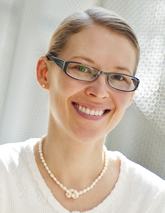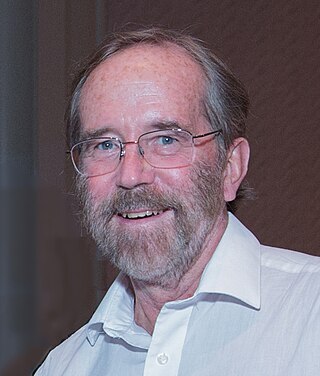Related Research Articles
A heterojunction is an interface between two layers or regions of dissimilar semiconductors. These semiconducting materials have unequal band gaps as opposed to a homojunction. It is often advantageous to engineer the electronic energy bands in many solid-state device applications, including semiconductor lasers, solar cells and transistors. The combination of multiple heterojunctions together in a device is called a heterostructure, although the two terms are commonly used interchangeably. The requirement that each material be a semiconductor with unequal band gaps is somewhat loose, especially on small length scales, where electronic properties depend on spatial properties. A more modern definition of heterojunction is the interface between any two solid-state materials, including crystalline and amorphous structures of metallic, insulating, fast ion conductor and semiconducting materials.

The Molecular Foundry is a nanoscience user facility located at the Lawrence Berkeley National Laboratory in Berkeley, California, and is one of five Nanoscale Science Research Centers sponsored by the United States Department of Energy.
Sir Mark Edward Welland, is a British physicist who is a professor of nanotechnology at the University of Cambridge and head of the Nanoscience Centre. He has been a fellow of St John's College, Cambridge, since 1986 and started his career in nanotechnology at IBM Research, where he was part of the team that developed one of the first scanning tunnelling microscopes. He was served as the Master of St Catharine's College, Cambridge and took up office from 2016 to 2023.
The Alan T. Waterman Award, named after Alan Tower Waterman, is the United States's highest honorary award for scientists no older than 40, or no more than 10 years past receipt of their Ph.D. It is awarded on a yearly basis by the National Science Foundation. In addition to the medal, the awardee receives a grant of $1,000,000 to be used at the institution of their choice over a period of five years for advanced scientific research.

The Fritz Haber Institute of the Max Planck Society (FHI) is a science research institute located at the heart of the academic district of Dahlem, in Berlin, Germany.
The William O. Baker Award for Initiatives in Research, previously the NAS Award for Initiatives in Research, is awarded annually by the National Academy of Sciences "to recognize innovative young scientists and to encourage research likely to lead toward new capabilities for human benefit. The award is to be given to a citizen of the United States, preferably no older than 35 years of age. The field of presentation rotates among the physical sciences, engineering, and mathematics."

Ernst G. Bauer is a German-American physicist known for his studies in the field of surface science, thin film growth and nucleation mechanisms and the invention in 1962 of the Low Energy Electron Microscopy (LEEM). In the early 1990s, he extended the LEEM technique in two directions by developing Spin-Polarized Low Energy Electron Microscopy (SPLEEM) and Spectroscopic Photo Emission and Low Energy Electron Microscopy (SPELEEM). He is currently Distinguished Research Professor Emeritus at the Arizona State University.

Walter Alexander "Walt" de Heer is a Dutch physicist and nanoscience researcher known for discoveries in the electronic shell structure of metal clusters, magnetism in transition metal clusters, field emission and ballistic conduction in carbon nanotubes, and graphene-based electronics.
The Nevill Mott Medal and Prize is an award presented in selected years by the Institute of Physics in the United Kingdom, for distinguished research in condensed matter or materials physics. It was first established in 1997 thanks to a donation from Sir Nevill Mott's family. Sir Nevill Mott was one of the outstanding British condensed matter theorists and won a Nobel Prize in Physics in 1977. He died in 1996. The award consists of a silver medal and a prize of £1000.
Umesh Waghmare is an Indian physicist, and presently a Professor in the Theoretical Sciences Unit at Jawaharlal Nehru Centre for Advanced Scientific Research.

Alexander A. Balandin is an electrical engineer, solid-state physicist, and materials scientist best known for the experimental discovery of unique thermal properties of graphene and their theoretical explanation; studies of phonons in nanostructures and low-dimensional materials, which led to the development of the field of phonon engineering; investigation of low-frequency electronic noise in materials and devices; and demonstration of the first charge-density-wave quantum devices operating at room temperature.
MEMS for in situ mechanical characterization refers to microelectromechanical systems (MEMS) used to measure the mechanical properties of nanoscale specimens such as nanowires, nanorods, whiskers, nanotubes and thin films. They distinguish themselves from other methods of nanomechanical testing because the sensing and actuation mechanisms are embedded and/or co-fabricated in the microsystem, providing—in the majority of cases—greater sensitivity and precision.
Mark S. Lundstrom is an American electrical engineering researcher, educator, and author. He is known for contributions to the theory, modeling, and understanding of semiconductor devices, especially nanoscale transistors, and as the creator of the nanoHUB, a major online resource for nanotechnology. Lundstrom is Don and Carol Scifres Distinguished Professor of Electrical and Computer Engineering and in 2020 served as Acting Dean of the College of Engineering at Purdue University, in West Lafayette, Indiana.
Julia Wan-Ping Hsu is an American materials scientist. In her research, she uses scanning probe microscopy to study the nanostructure, optics, and photoelectric properties of thin films and crystal surfaces, with particular application to solar cells, and has used nanotransfer printing to make electrical connections to single-molecule sensing devices. She is a professor of materials science and engineering at the University of Texas at Dallas, where she holds the Texas Instruments Distinguished Chair in Nanoelectronics.
Xu Jianbin is a professor in the department of electronic engineering and director of material research center at The Chinese University of Hong Kong (CUHK). He is also a Distinguished Research Fellow at the Shenzhen Institutes of Advanced Technology, one of the Chinese Academy of Sciences.
Yuri Suzuki is a Professor of Applied Physics at Stanford University. She studies novel ground states and magnetic phenomena. She is a Fellow of the American Physical Society and an American Competitiveness and Innovation Fellow of the National Science Foundation.

Alexandra Boltasseva is Ron And Dotty Garvin Tonjes Distinguished Professor of electrical and computer engineering at Purdue University, and editor-in-chief for The Optical Society's Optical Materials Express journal. Her research focuses on plasmonic metamaterials, manmade composites of metals that use surface plasmons to achieve optical properties not seen in nature.

Patricia Ann Thiel was an American chemist and materials scientist who served as a distinguished professor of chemistry at Iowa State University. She was known for her research on atomic-scale structures and processes on solid surfaces.

Joseph "Joe" E. Greene, known in his professional writing as J. E. Greene was an American materials scientist, specializing in thin films, crystal growth, surface science, and advanced surface engineering. His research and scientific contributions in these areas have been described as "pioneering" and "seminal" and that his work "revolutionized the hard-coating industry".

Aristos Christou is an American engineer and scientist, academic professor and researcher. He is a Professor of Materials Science, Professor of Mechanical Engineering and Professor of Reliability Engineering at the University of Maryland.